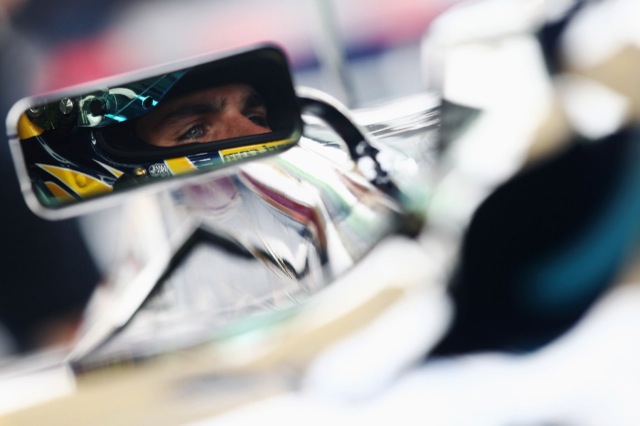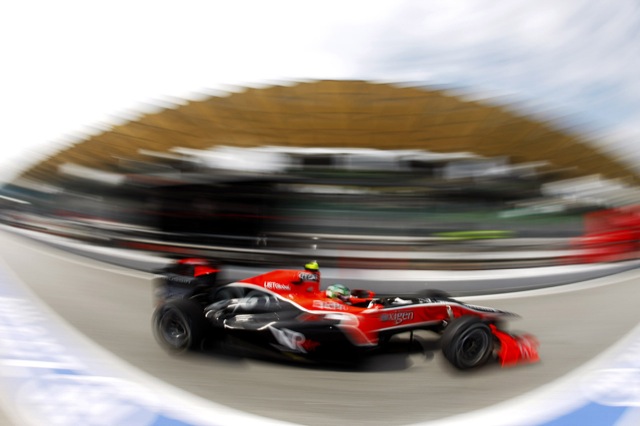 Formula One has now entered its off-season phase. A time when the pace of the circus slows a little and the teams get to flex their muscles not on the race track, but behind closed doors in the wind tunnel and in front of the computer screens. The designing of the 2008 cars has already been well underway, some of the richer squads starting not long after the first race of 2007. The long-term plans have been put in place and the operations of developing the new car is in full swing. However, there is only one real way of knowing if your new car is any good, and as racing is out of the question during the winter, the next best option is testing. But is it really worth following?
Formula One has now entered its off-season phase. A time when the pace of the circus slows a little and the teams get to flex their muscles not on the race track, but behind closed doors in the wind tunnel and in front of the computer screens. The designing of the 2008 cars has already been well underway, some of the richer squads starting not long after the first race of 2007. The long-term plans have been put in place and the operations of developing the new car is in full swing. However, there is only one real way of knowing if your new car is any good, and as racing is out of the question during the winter, the next best option is testing. But is it really worth following?
Seeing the cars being driven outside of the competitive nature of the races is actually quite interesting. It is during these cold and damp days at a mirky Silverstone that the multi-million dollar machines sprout extra winglets, mirrors, aerodynamic ornaments and of course, some under-the-skin changes as well. Earlier in the season Honda ran their hopeless RA107 at the Bahrain circuit, complete with McLaren-style bridge over the nose cone. At an even earlier test the Brackley team’s car developed ears on each side of the nose, all in a bid to improve it’s woeful handling. Neither device made to the car in a full-time capacity, but the devices caused quite a stir when they were presented at the test sessions.
So one plus point from testing is seeing all the crazy parts the teams run on the cars before deciding they don’t work and filing them in the bin. Another reason why testing should be followed is of course the times. Although this is sometimes very difficult to accurately judge. When the crews test the cars, they could be testing anything. Literally. Often, and particularly with a rookie driver, the teams will practice pit stops until the cows come home. And after sunset, the pit box will be floodlit and the car will be rolled into  place to give the mechanics even more chance to get it right. Looking at Kazuki Nakajima’s first career F1 stop just makes you realise how important this is.
place to give the mechanics even more chance to get it right. Looking at Kazuki Nakajima’s first career F1 stop just makes you realise how important this is.
So, my point? Well, when your practicing pit stops, the lap time is irrelevant. Therefore, the time cannot be taken into consideration. The same applies to when a team is running a full race simulation. Often the drivers will be sent out to complete 70 laps and stop twice, just like in an average race. This allows the technical experts to gain a lot of useful information about tyre wear, fuel consumption, engine durability, as well as offering the chance for the drivers health and fitness to be assessed. But again, lap times during a race tend to be all over the place. There are times when a driver pops in a few qualifying-type laps, and others when he is simply on cruise control, doing the minimum to stay ahead.
And even if the teams testing were to send the cars out for a faux pas qualifying run, we still wouldn’t know how much fuel was on board. We don’t even know if the car is legal to Formula One regulations as it matters less during testing.
One reason why I do like to follow testing, though, is I can see the big picture. Not just a picture of a day when I look a various lap times set at different parts of the session. And not just a picture of the whole test, which may be a complete week. I will often look at the off-season testing in three groups; pre-Christmas, post-Christmas and pre-season.
The pre-Christmas runs tend to be with interim cars, or even the old car if the parts are not ready yet. Often these tests are carried out in private, so any comparative lap times is impossible to see. But I can usually tell if the car has improved since the final few races of the year. It tends to more down to the drivers short speech to the press that gives away the little inklings of how the car is developing, but if you read between the lines and are cynical enough, there is sometimes some truth to be had. Pre-Christmas testing is also nice because often the teams will run their new drivers if their contracts allow it. Failing that, we get to see more of  Pedro De La Rosa, James Rossiter, Luca Badoer and maybe even a glimpse of Gary Paffett. In other words, we get to see and hear from the test drivers.
Pedro De La Rosa, James Rossiter, Luca Badoer and maybe even a glimpse of Gary Paffett. In other words, we get to see and hear from the test drivers.
Post-Christmas testing is when things start to hot up a little. The teams generally organise proper sessions at various circuits around the world, mainly staying in the warmer climes where possible. This is where comparative lap times can be viewed and a vague idea of where everyone is starts to form. All the teams run their drivers for the upcoming season and everything gets a little bit more exciting. As the cars are released new liveries can be viewed (normally) and the radical ideas that some teams introduce become apparent to one and all.
This is an interesting time of year because if the car is wrong, it is often too late to change it, despite the obviousness of the situation. We saw this with Honda and Renault in January 2007. They knew back then that their cars weren’t quite as good as their  predecessors, but it was too late to go back to the drawing board. Typically, this is where the crazy winglets and elephant ears get stuck on – it’s really all out of desperation.
predecessors, but it was too late to go back to the drawing board. Typically, this is where the crazy winglets and elephant ears get stuck on – it’s really all out of desperation.
And finally, the pre-season test is where the cars are put into their racing trim and tested properly to accurately gauge as best as possible how it will handle at the first Grand Prix of the year. This test tends to happen either somewhere close to the teams home country, (Paul Ricard is popular for this due to its changeable layout) or somewhere near the first race of the season. Last time most squads headed to Bahrain for a weeks worth of testing, the circuits interesting collection of corners and relative locality to Australia being some of the reasons for the choice.
This test session is usual a good indication of what to expect at the first round, although even at this late stage some teams are running slower than normal or even faster than normal. It still is hard to get an accurate picture of where every team is, but it is the best time to judge the grid.
So, will you be following testing this off-season, or do you find it boring? What if there was a way to spice up the test sessions, it would certainly help us folk who have to suffer a cold winter with no Formula One action. Perhaps the teams should be forced to run a hot lap at the end of each day so comparative times can be assessed? What if the squads were forced to hold non-championship races during this period, perhaps running older cars and all done in the name of fun? I know it would probably keep me interested if it was properly broadcast. Hard to organise, no doubt, but I would love to hear your ideas for off-season fun and games that the teams could do. Oh, and the original question: Will you be following the off-season testing?






















To be honest I’ve not followed testing in too much detail in the past – usually only really followed the headlines of So-and-so being fastest at Barcelona or whatever.
This winter I do plan to take a more active look at things – especially if all the information is available nicely in one place, ie here!
It’s going to be a long winter without any races, but let’s hope there is still plenty to talk about.
I take a look at testing, but it’s more for striking patterns (if a team is consistently unreliable or never leaves the bottom of the time sheets after Christmas, it’s in trouble) and discrepancies (yes, Fernando, I am referring to the contrast between your comments and the McLaren’s pace in pre-season testing). There are some problems, though – too often, the winner of the “Winter World Championships” fares relatively poorly when the “Summer World Championships” come round. The best example being Prost in 2001…
@Craig: I’ll try to cover the testing. I did quite well last year, so there is hope!
@Alianora: Striking patterns are probably the best way to look at the times and teams. This is why I tend to look at the winter in three stages. But as you say, sometimes even that can be misleading – Massa did really well last year, but his season wasn’t the greatest. He did well, but he wasn’t challenging for the title at the end.